Performance Enhancement Analysis of Environmentally Friendly Refrigerants
Abstract
1. Introduction
2. Analysis
- Steady flow in each component of the system;
- Negligible changes in potential and kinetic energy from entry to exit of each component in the system;
- Isentropic compression in the compressor of the system;
- Insignificant pressure drops in the system’s pipeline;
- Isenthalpic process in the expansion valve of the system.
2.1. Single-Stage Vapor Compression Refrigeration System
2.2. Two-Stage Vapor Compression Refrigeration System
2.3. Refrigerants
3. Solution Procedure and Verification
3.1. Single-Stage Vapor Compression Refrigeration System
3.2. Two-Stage Vapor Compression Refrigeration System
3.3. Verification
4. Results and Discussion
4.1. Single-Stage Vapor Compression Refrigeration System
4.2. Double-Stage Vapor Compression Refrigeration System
4.3. Mixture with Optimum Mass Fractions
5. Conclusions
- When the evaporation temperature was fixed, the higher the condensation temperature, the lower the COP of the refrigeration system; when the condensation temperature was fixed, the evaporation temperature became higher, and a higher COP of the system was obtained.
- R1234ze(Z), R601, and R1233zd(E) had the best refrigeration performances among the environmentally friendly refrigerants studied, while R441A performed the worst for Teva = 10 °C and −20 °C.
- RE170 had the highest COP of the refrigeration system for Teva = −40 °C and −60 °C. However, R1234yf showed a worse performance in terms of COP when the evaporation temperature was much lower, and it ranked last for Teva = −60 °C.
- While changing from a single-stage to two-stage vapor compression refrigeration system, the percentage increase in the COP of the system with R1234yf was the largest for Teva = −40 °C and −60 °C. However, the growth rate of R717 ranked last for Teva = −60 °C.
- The maximum coefficients of performance of the refrigeration systems using an R717/R1234yf mixture were 4.120, 3.278, and 2.654 at optimum mass fractions of 0.18, 0.21, and 0.25, respectively, for Tcon = 30, 40, and 50 °C and Tvea = −20 °C.
- At an optimal α of 0.18, the COP, Pdis, and Tdis of the refrigeration system using R717/R1234yf (82/18 wt%) were about 10.2%, 4.6%, and 84.3% higher than those of R1234yf, respectively, for Tcon = 30 °C and Tvea = −20 °C.
- For the R717/R1234yf mixture, at an optimum α of 0.25, the COP of the refrigeration system can be increased up to 25.8% despite an increase of 15.2% in the operating pressure compared to R1234yf. The discharge temperature of the compressor may also rise; however, there will be no overheating problem.
Author Contributions
Funding
Data Availability Statement
Conflicts of Interest
Abbreviations
| Nomenclature | |
| h | enthalpy of refrigerant, kJ/kg |
| P | pressure, kPa |
| T | temperature, °C |
| Greek symbols | |
| α | mass fraction, defined in Equation (5) |
| Acronym | |
| CFC | chlorofluorocarbon |
| COP | coefficient of performance |
| GWP | global warming potential |
| HC | hydrocarbon |
| HCFC | hydrochlorofluorocarbon |
| HCFO | hydrochlorofluoroolefin |
| HFC | hydrofluorocarbon |
| HFO | hydrofluoroolefin |
| NIST | National Institute of Standards and Technology |
| ODP | ozone depletion potential |
| REFPROP | REFerence fluid PROPerties |
| Subscripts | |
| 1–9 | state |
| con | condensation |
| dis | discharge |
| dou | double |
| eva | evaporation |
| g | vapor |
| i | intermediate |
| max | maximum |
| s | entropy |
| sin | single |
| Superscripts | |
| * | dimensionless parameter, used in Equation (4) |
References
- Yang, M.H.; Yeh, R.H. Theoretical analysis of optimal subcooling for single vapor-compression refrigeration systems. Heat. Transf. Eng. 2015, 36, 912–925. [Google Scholar] [CrossRef]
- Yang, M.H.; Yeh, R.H. Performance and exergy destruction analyses of optimal subcooling for vapor-compression refrigeration systems. Int. J. Heat. Mass. Transf. 2015, 87, 1–10. [Google Scholar] [CrossRef]
- Sánchez, D.; Cabello, R.; Llopis, R.; Arauzo, I.; Catalán-Gil, J.; Torrella, E. Energy performance evaluation of R1234yf, R1234ze(E), R600a, R290 and R152a as low-GWP R134a alternatives. Int. J. Refrig. 2017, 74, 269–282. [Google Scholar] [CrossRef]
- Longo, G.A.; Mancin, S.; Righetti, G.; Zilio, C. Hydrocarbon refrigerants HC290 (Propane) and HC1270 (Propylene) low GWP long-term substitutes for HFC404A: A comparative analysis in vaporisation inside a small-diameter horizontal smooth tube. Appl. Therm. Eng. 2017, 124, 707–715. [Google Scholar] [CrossRef]
- Sun, Z.; Wang, Q.; Xie, Z.; Liu, S.; Su, D.; Cui, Q. Energy and exergy analysis of low GWP refrigerants in cascade refrigeration system. Energy 2019, 170, 1170–1180. [Google Scholar] [CrossRef]
- Cabello, R.; Sánchez, D.; Llopis, R.; Andreu-Nacher, A.; Calleja-Anta, D. Energy impact of the Internal Heat Exchanger in a horizontal freezing cabinet. Experimental evaluation with the R404A low-GWP alternatives R454C, R455A, R468A, R290 and R1270. Int. J. Refrig. 2022, 137, 22–33. [Google Scholar] [CrossRef]
- Sánchez, D.; Andreu-Nácher, A.; Calleja-Anta, D.; Llopis, R.; Cabello, R. Energy impact evaluation of different low-GWP alternatives to replace R134a in a beverage cooler. Experimental analysis and optimization for the pure refrigerants R152a, R1234yf, R290, R1270, R600a and R744. Energy Convers. Manag. 2022, 256, 115388. [Google Scholar] [CrossRef]
- Belman-Flores, J.M.; Heredia-Aricapa, Y.; Pardo-Cely, D.; Rodríguez-Valderrama, D.A.; Alba-Rosano MDe Silva-Romero, J.C. Experimental evaluation of R513A as a low GWP refrigerant to replace R134a in a domestic refrigerator. Int. J. Refrig. 2022, 142, 148–155. [Google Scholar] [CrossRef]
- Kumma, N.; Sarath, S.; Kruthiventi, S.S.H. Exergy and performance analysis of low GWP and Non-flammable HFO based refrigerant mixtures as alternatives to R134a. Therm. Sci. Eng. Prog. 2023, 39, 101691. [Google Scholar] [CrossRef]
- Makhnatch, P.; Khodabandeh, R. The role of environmental metrics (GWP, TEWI, LCCP) in the selection of low GWP refrigerant. Energy Procedia 2014, 61, 2460–2463. [Google Scholar] [CrossRef]
- Mota-Babiloni, A.; Navarro-Esbrí, J.; Peris, B.; Molés, F.; Verdú, G. Experimental evaluation of R448A as R404A lower-GWP alternative in refrigeration systems. Energy Convers. Manag. 2015, 105, 756–762. [Google Scholar] [CrossRef]
- Domanski, P.A.; Brignoli, R.; Brown, J.S.; Kazakov, A.F.; McLinden, M.O. Low-GWP refrigerants for medium and high pressure applications. Int. J. Refrig. 2017, 84, 198–209. [Google Scholar] [CrossRef] [PubMed]
- Meng, Z.; Zhang, H.; Lei, M.; Qin, Y.; Qiu, J. Performance of low GWP R1234yf/R134a mixture as a replacement for R134a in automotive air conditioning systems. Int. J. Heat. Mass. Transf. 2018, 116, 362–370. [Google Scholar] [CrossRef]
- Llopis, R.; Calleja-Anta, D.; Sánchez, D.; Nebot-Andrés, L.; Catalán-Gil, J.; Cabello, R. R-454C, R-459B, R-457A and R-455A as low-GWP replacements of R-404A: Experimental evaluation and optimization. Int. J. Refrig. 2019, 106, 133–143. [Google Scholar] [CrossRef]
- Makhnatch, P.; Mota-Babiloni, A.; Lopez-Belchí, A.; Khodabandeh, R. R450A and R513A as lower GWP mixtures for high ambient temperature countries: Experimental comparison with R134a. Energy 2019, 166, 223–235. [Google Scholar] [CrossRef]
- Li, Z.; Jiang, H.; Chen, X.; Liang, K. Comparative study on energy efficiency of low GWP refrigerants in domestic refrigerators with capacity modulation. Energy Build. 2019, 192, 93–100. [Google Scholar] [CrossRef]
- Qin, Y.; Li, N.; Zhang, H.; Liu, B. Energy and exergy analysis of a Linde-Hampson refrigeration system using R170, R41 and R1132a as low-GWP refrigerant blend components to replace R23. Energy 2021, 229, 120645. [Google Scholar] [CrossRef]
- Oruç, V.; Devecioglu, A. Experimental investigation on the low-GWP HFC/HFO blends R454A and R454C in a R404A refrigeration system. Int. J. Refrig. 2021, 128, 242–251. [Google Scholar] [CrossRef]
- Deymi-Dashtebayaz, M.; Sulin, A.; Ryabova, T.; Sankina, I.; Farahnak, M.; Nazeri, R. Energy, exergoeconomic and environmental optimization of a cascade refrigeration system using different low GWP refrigerants. J. Environ. Chem. Eng. 2021, 9, 106473. [Google Scholar] [CrossRef]
- Faruque, M.W.; Uddin, M.R.; Salehin, S.; Ehsan, M.M. A comprehensive thermodynamic assessment of cascade refrigeration system utilizing low GWP hydrocarbon refrigerants. Int. J. Thermofluids 2022, 15, 100177. [Google Scholar] [CrossRef]
- Işkan, Ü.; Direk, M. Experimental performance evaluation of the dual-evaporator ejector refrigeration system using environmentally friendly refrigerants of R1234ze (E), ND, R515a, R456a, and R516a as a replacement for R134a. J. Clean. Prod. 2022, 352, 131612. [Google Scholar] [CrossRef]
- Saleem, S.; Bradshaw, C.R.; Bach, C.K. Development of design guidelines for fin-and-tube heat exchangers with low-GWP refrigerants. Int. J. Refrig. 2022, 143, 166–181. [Google Scholar] [CrossRef]
- Al-Sayyab, A.K.S.; Navarro-Esbrí, J.; Barrag’an-Cervera, A.; Sarah Kim, S.; Mota-Babiloni, A. Comprehensive experimental evaluation of R1234yf-based low GWP working fluids for refrigeration and heat pumps. Energy Convers. Manag. 2022, 258, 115378. [Google Scholar] [CrossRef]
- Conte, R.; Azzolin, M.; Bernardinello, S.; Del Col, D. Experimental investigation of large scroll compressors working with six low-GWP refrigerants. Therm. Sci. Eng. Prog. 2023, 44, 102043. [Google Scholar] [CrossRef]
- List of Refrigerants. Available online: https://en.wikipedia.org/wiki/List_of_refrigerants (accessed on 4 April 2024).
- NIST Thermodynamic and Transport Properties of Refrigerants and Refrigerant Mixtures REFPROP; Version 9.1; National Institute of Standards and Technology: Gaithersburg, MD, USA, 2016.
- Saleh, B.; Aly, A.A.; Alsehli, M.; Elfasakhany, A.; Bassuoni, M.M. Performance analysis and working fluid selection for single and two stages vapor compression refrigeration cycles. Processes 2020, 8, 1017. [Google Scholar] [CrossRef]
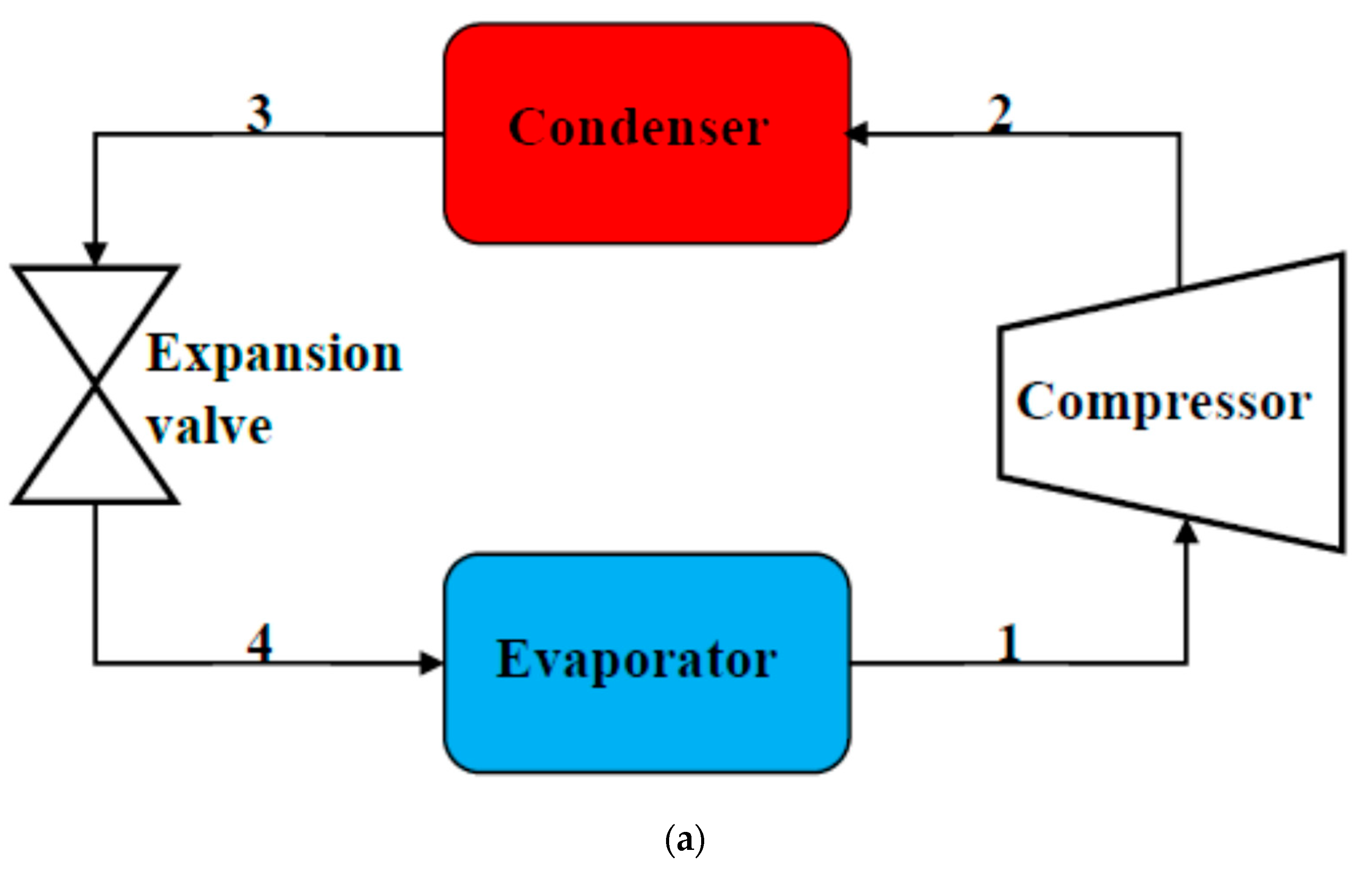
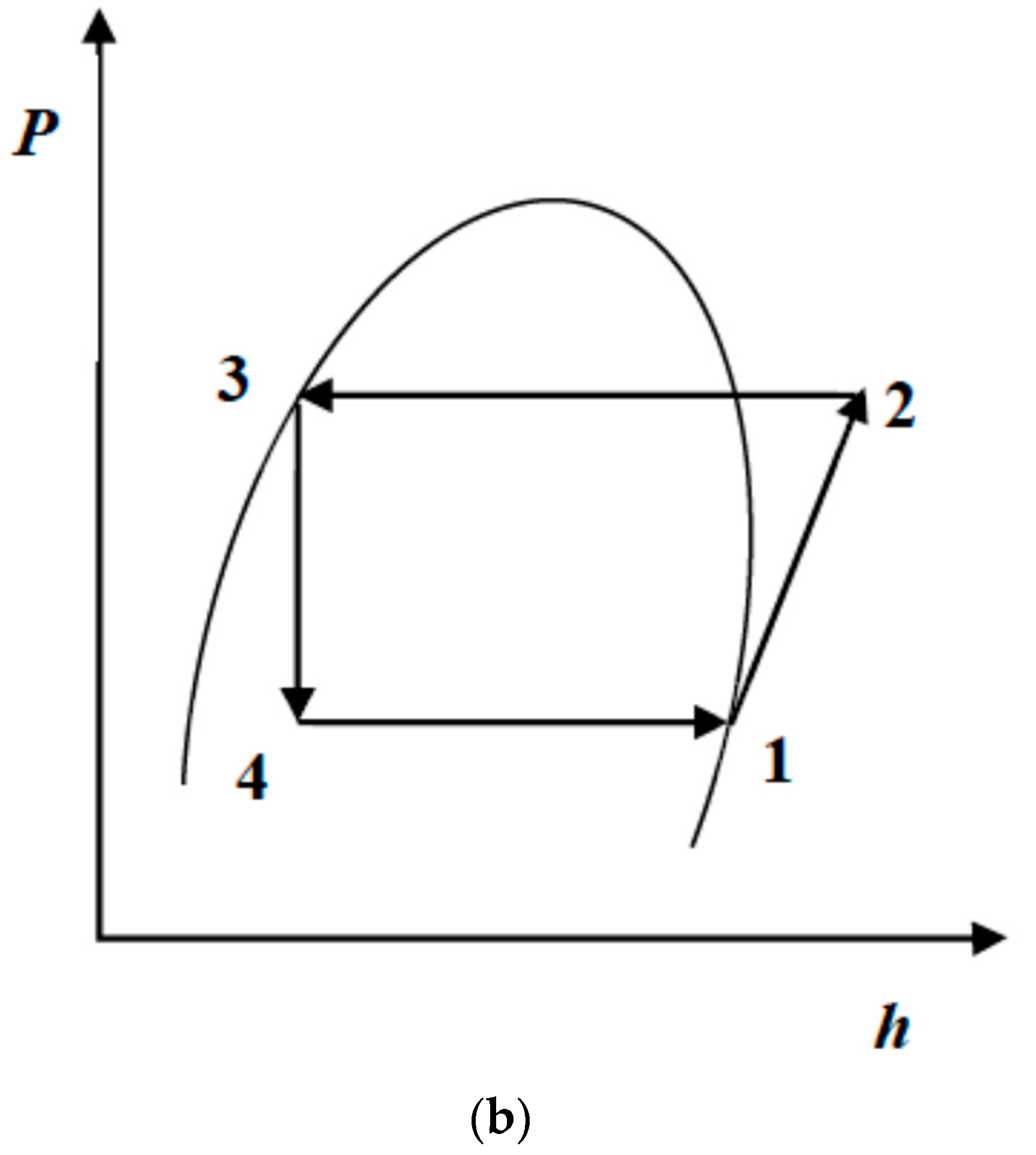
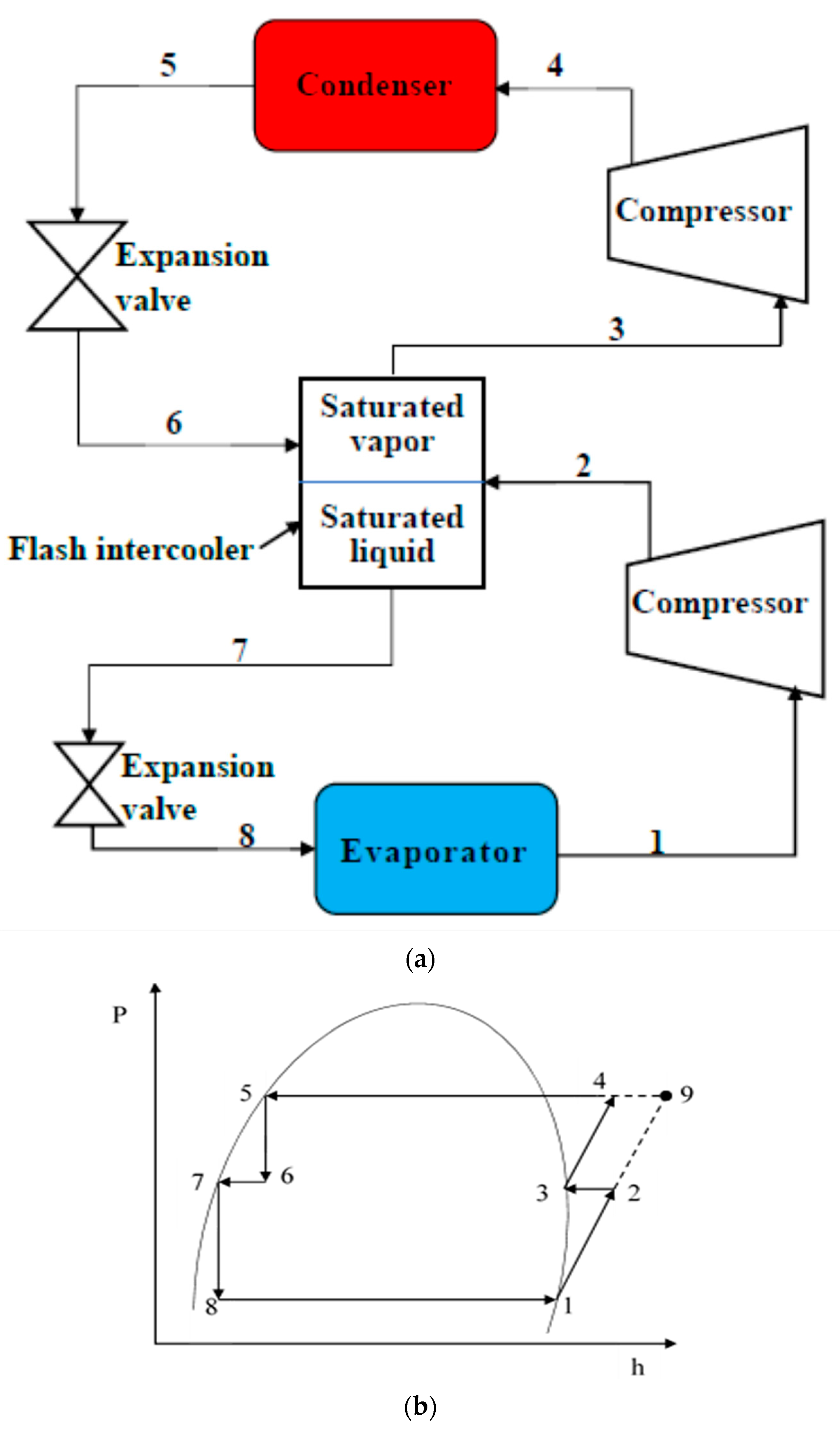
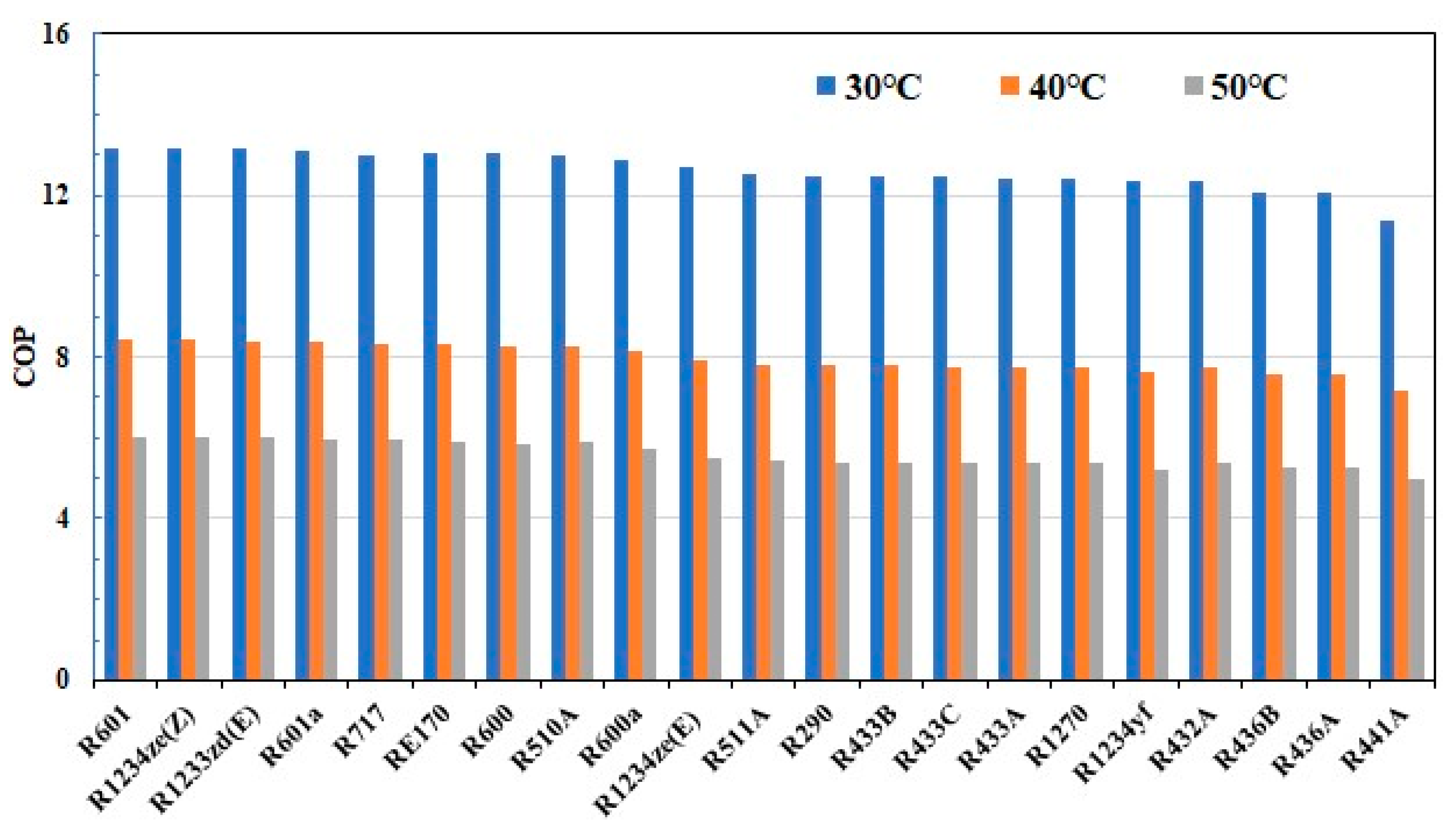
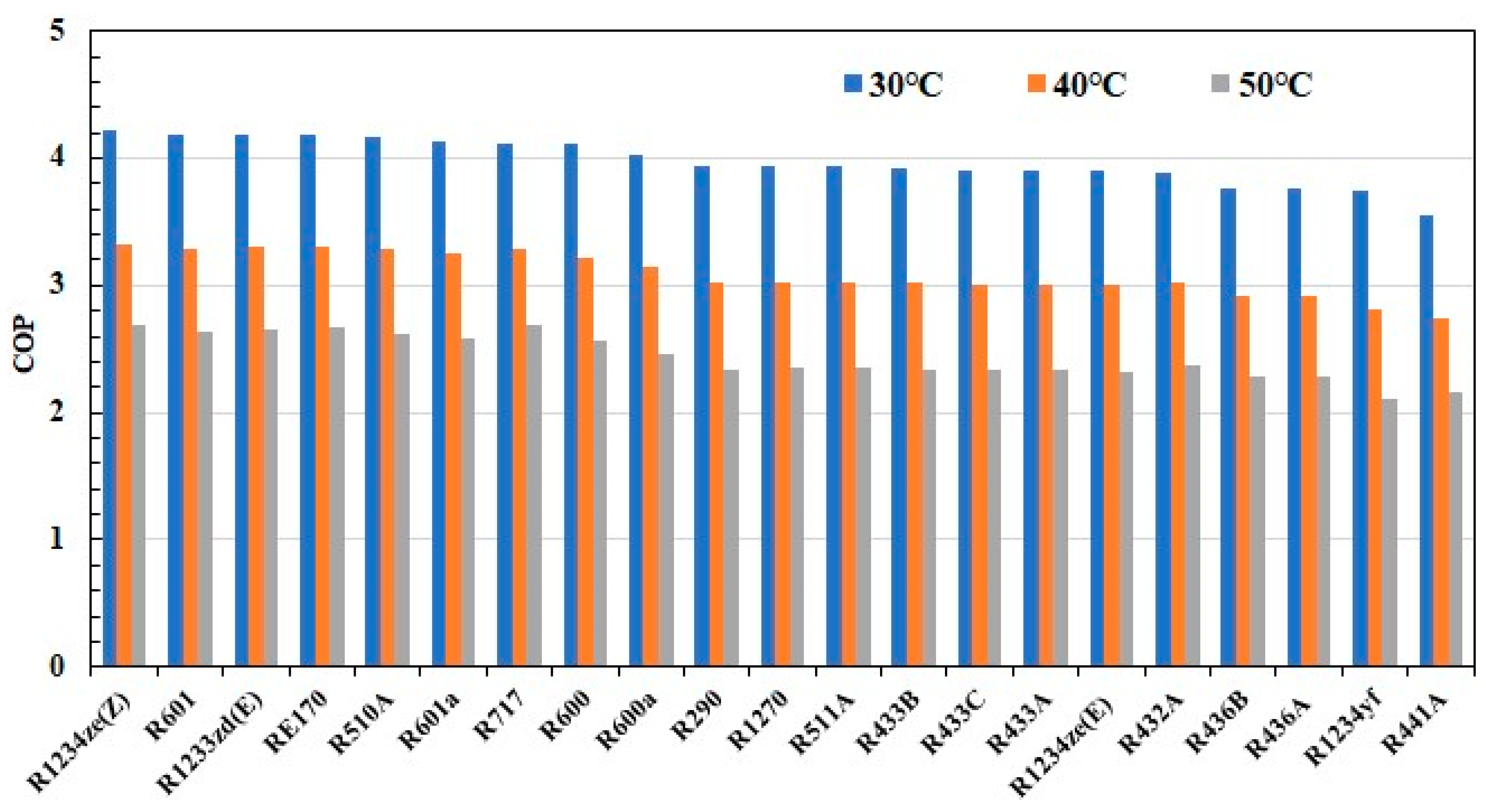
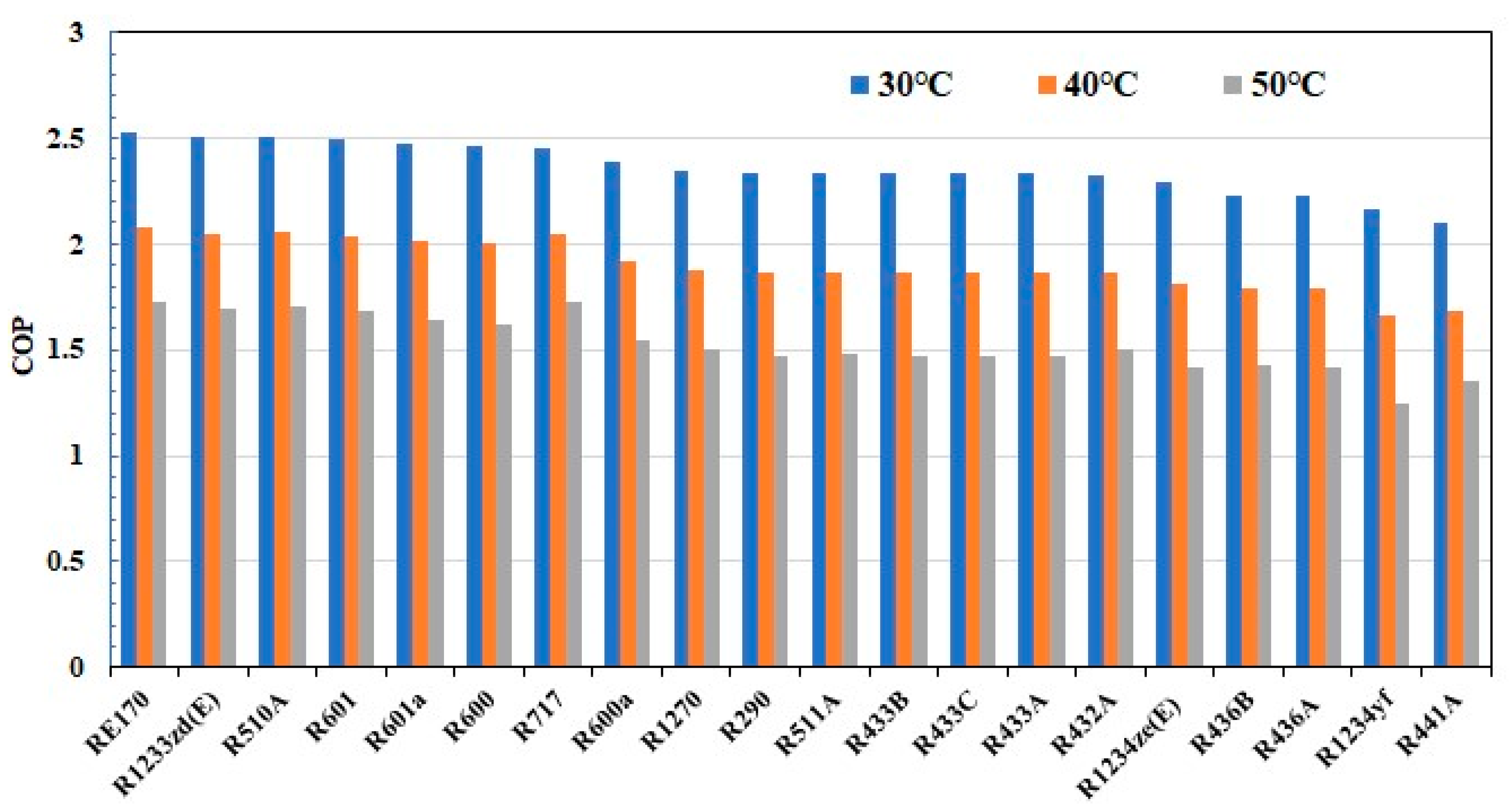
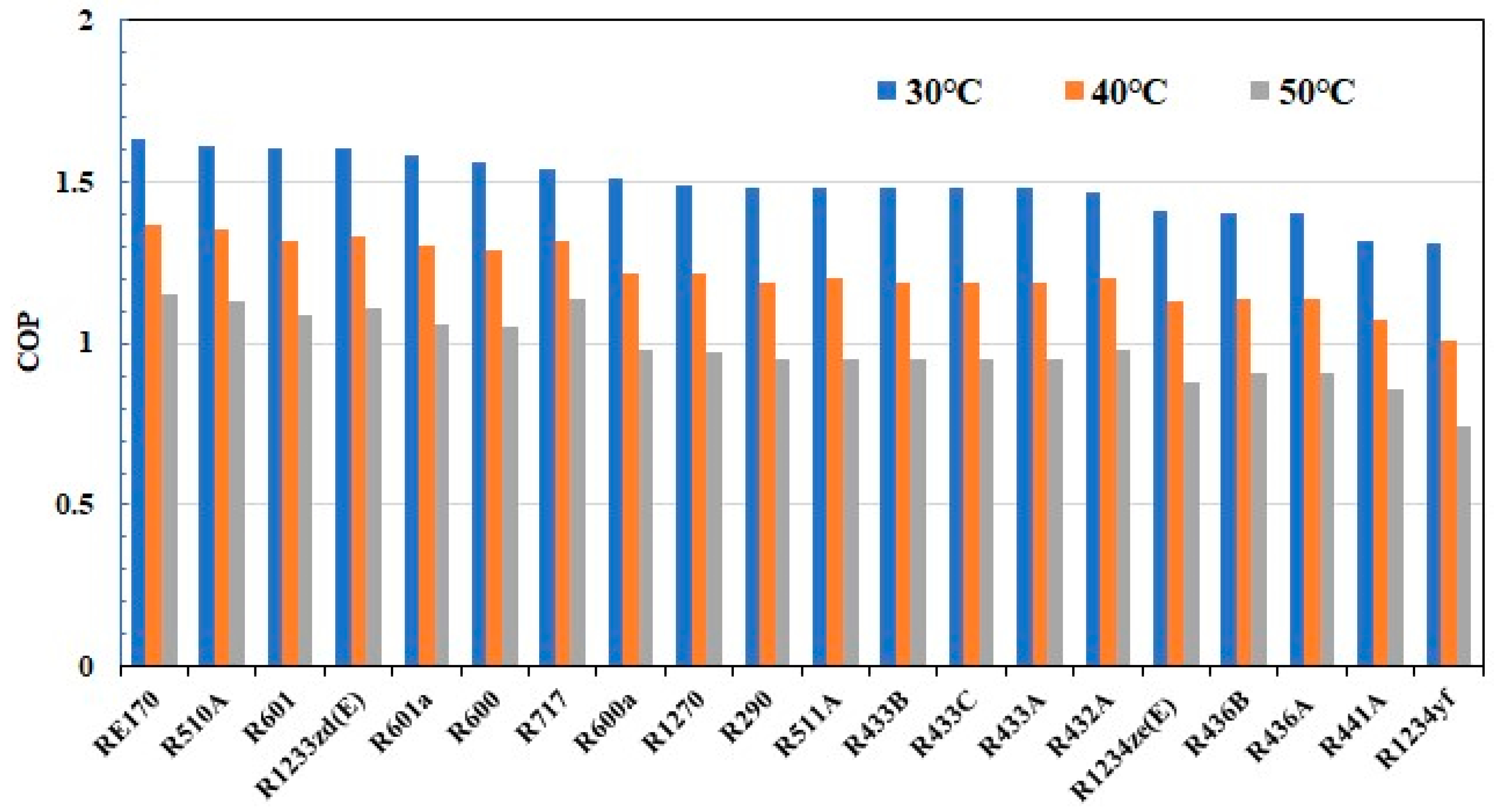
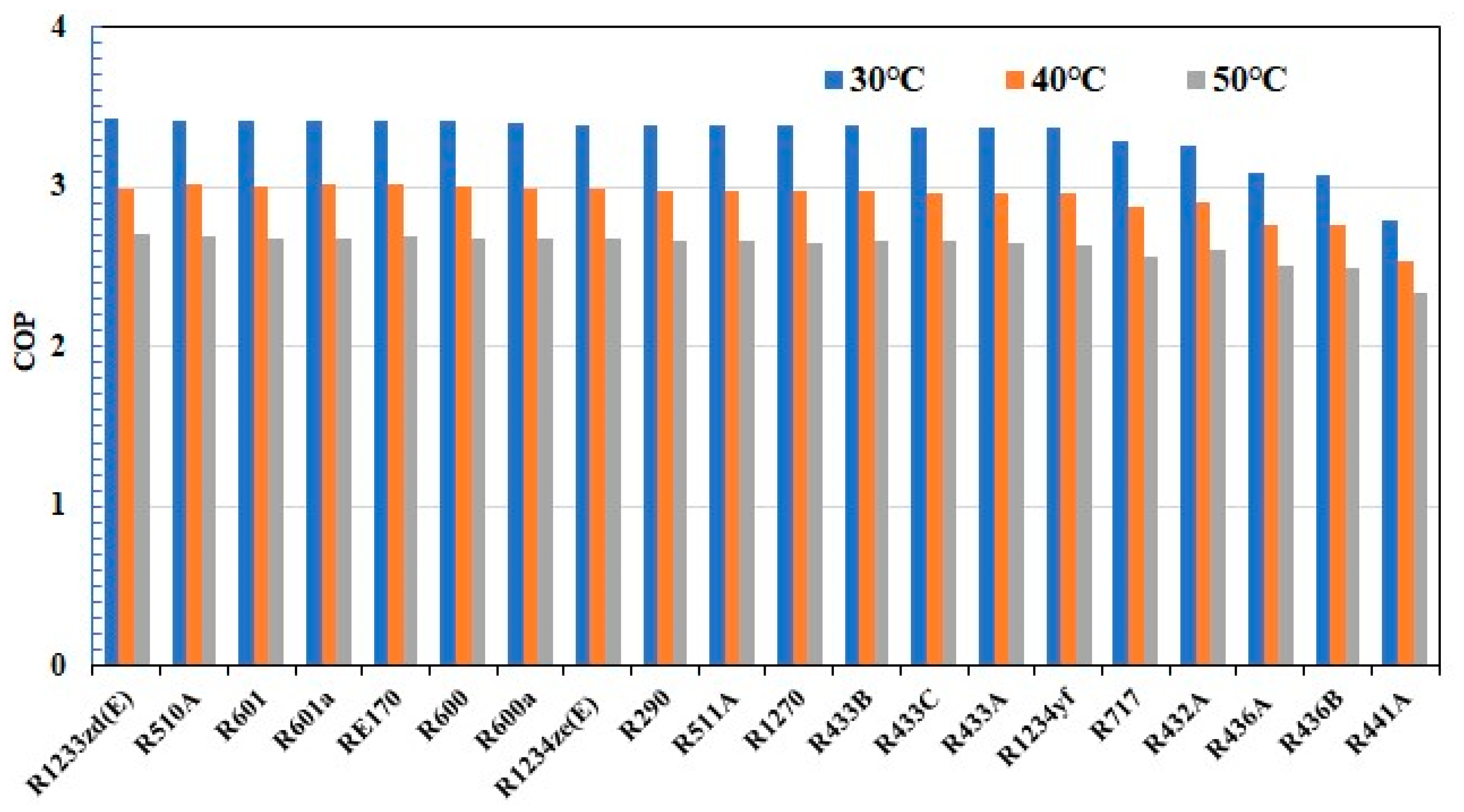


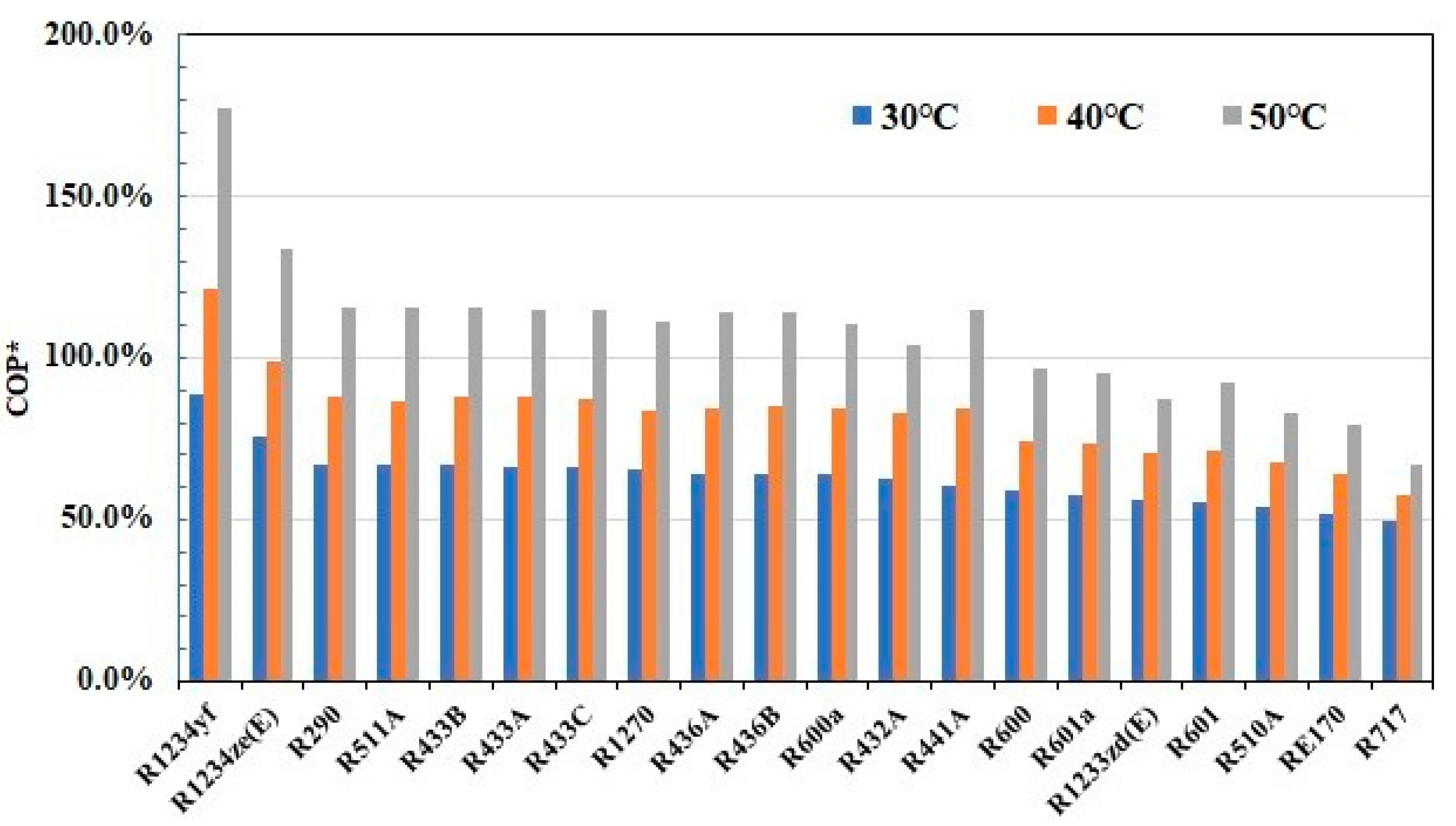

| TYPE | ASHRAE Number | Molecular Formula | COP | GWP100 | Safety Group |
|---|---|---|---|---|---|
| HC | RE170 | C2H6O | 0 | 1 | B2L |
| HC | R290 | C3H8 | 0 | 3.3 | A3 |
| HC | R436A | 56% R290, 44% R600a | 0 | 3.17 | A3 |
| HC | R436B | 52% R290, 48% R600a | 0 | 3.16 | A3 |
| HC | R441A | 3.1% R170, 54.8% R290, 6% R600a, 36.1% R600 | 0 | 3.6 | A3 |
| HC | R510A | 88% RE170, 12% R600a | 0 | 1.24 | A3 |
| HC | R511A | 95% R290, 5% RE170 | 0 | 3.19 | A3 |
| HC | R600 | C4H10 | 0 | 4 | A3 |
| HC | R600a | C4H10 | 0 | 3 | A3 |
| HC | R601 | C5H12 | 0 | 5 | A3 |
| HC | R601a | C5H12 | 0 | 5 | A3 |
| HO | R432A | 80% R1270, 20% RE170 | 0 | 1.64 | A3 |
| HO | R433A | 30% R1270, 70% R290 | 0 | 2.85 | A3 |
| HO | R433B | 5% R1270, 95% R290 | 0 | 3.23 | A3 |
| HO | R433C | 25% R1270, 75% R290 | 0 | 2.93 | A3 |
| HO | R1270 | C3H6 | 0 | 1.8 | A3 |
| Natural | R717 | NH3 | 0 | 0 | B2L |
| HFO | R1234yf | C3H2F4 | 0 | 4 | A2L |
| HFO | R1234ze(E) | C3H2F4 | 0 | 6 | A2L |
| HFO | R1234ze(Z) | CH2F4 | 0 | 1.4 | A2L |
| HCFO | R1233zd(E) | C3H2ClF3 | 0 | 1 | A1 |
| ASHRAE Number | TYPE | COP (This Study) | COP [27] | Error Percentage % |
|---|---|---|---|---|
| R600 | HC | 3.87 | 3.87 | 0 |
| R600a | HC | 3.78 | 3.78 | 0 |
| R601 | HC | 3.93 | 3.93 | 0 |
| R601a | HC | 3.90 | 3.90 | 0 |
| RE170 | HC | 3.92 | 3.92 | 0 |
| R1233zd(E) | HCFO | 3.93 | 3.91 | 0.51 |
| R1234ze(E) | HFO | 3.66 | 3.68 | 0.54 |
| R1234yf | HFO | 3.51 | 3.51 | 0 |
| Tcon (°C) | Teva = −20 °C | ||||
|---|---|---|---|---|---|
| COPmax | α | Pdis (kPa) | Peva (kPa) | Tdis (°C) | |
| 30 | 4.120 | 0.18 | 819.2 | 138.4 | 55.3 |
| 40 | 3.278 | 0.21 | 1066.7 | 140.2 | 71.2 |
| 50 | 2.654 | 0.25 | 1500.2 | 141.8 | 93.9 |
Disclaimer/Publisher’s Note: The statements, opinions and data contained in all publications are solely those of the individual author(s) and contributor(s) and not of MDPI and/or the editor(s). MDPI and/or the editor(s) disclaim responsibility for any injury to people or property resulting from any ideas, methods, instructions or products referred to in the content. |
© 2024 by the authors. Licensee MDPI, Basel, Switzerland. This article is an open access article distributed under the terms and conditions of the Creative Commons Attribution (CC BY) license (https://creativecommons.org/licenses/by/4.0/).
Share and Cite
Hsieh, C.-Y.; Yeh, R.-H. Performance Enhancement Analysis of Environmentally Friendly Refrigerants. Processes 2024, 12, 904. https://doi.org/10.3390/pr12050904
Hsieh C-Y, Yeh R-H. Performance Enhancement Analysis of Environmentally Friendly Refrigerants. Processes. 2024; 12(5):904. https://doi.org/10.3390/pr12050904
Chicago/Turabian StyleHsieh, Chun-Yu, and Rong-Hua Yeh. 2024. "Performance Enhancement Analysis of Environmentally Friendly Refrigerants" Processes 12, no. 5: 904. https://doi.org/10.3390/pr12050904
APA StyleHsieh, C.-Y., & Yeh, R.-H. (2024). Performance Enhancement Analysis of Environmentally Friendly Refrigerants. Processes, 12(5), 904. https://doi.org/10.3390/pr12050904





